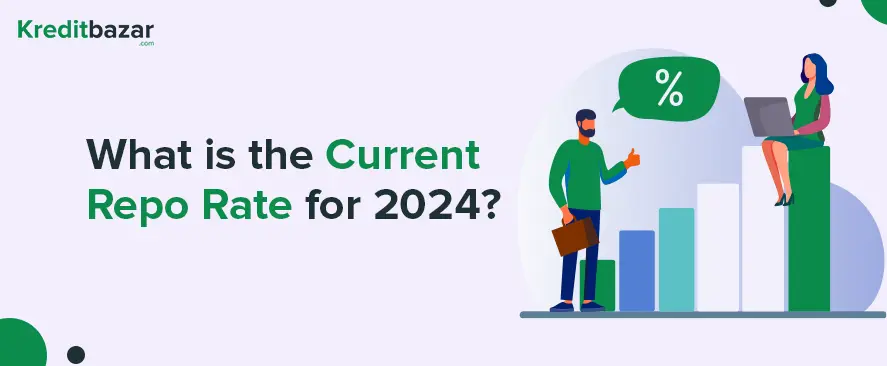![]()
The Reserve Bank of India (RBI) has maintained its repo rate at 6.50% for the tenth consecutive time, effective from 9th October 2024. Similarly, the reverse repo rate remains unchanged at 3.35%. These rates are crucial tools used by the RBI to manage inflation, control liquidity, and stabilize the economy.
Table of Contents
What is the Repo Rate?
The repo rate refers to the rate at which the RBI lends money to commercial banks when they face a shortage of funds. It is a pivotal mechanism for maintaining adequate liquidity in the market, ensuring that banks have access to funds, and regulating inflation. By adjusting the repo rate, the RBI influences interest rates, impacting loans and savings for individuals and businesses.
Key Repo Rate Statistics:
- Repo Rate: 6.50%
- Reverse Repo Rate: 3.35%
- Bank Rate: 6.75%
- Marginal Standing Facility Rate (MSF): 6.75%
What is Basis Point (BPS)?
Basis points (bps) are a common unit used to describe the rate of change in financial instruments or indices. One basis point is equal to 0.01%, or 1/100th of a percent. This measurement helps investors and economists easily express percentage changes in interest rates and other financial metrics.
Understanding How Repo Rate Works:
When banks borrow money from the RBI, they do so under the repo rate. In this transaction, banks must pledge eligible securities, such as Treasury Bills, to the RBI in exchange for cash. This system ensures liquidity for banks during cash shortages. The term “repo” stands for Repurchasing Option or Repurchase Agreement, where banks agree to repurchase these securities at a predetermined price, thereby repaying the RBI.
Why Does the Repo Rate Matter?
The repo rate directly impacts the cost of borrowing in the economy. When the repo rate is low, banks borrow more from the RBI, increasing their capacity to lend to consumers and businesses at lower interest rates. Conversely, a high repo rate discourages borrowing, tightening liquidity, and helping control inflation.
Recent Repo Rate Updates:
Here is a summary of the most recent repo rates announced by the RBI:
| Date | Repo Rate |
| 9th October 2024 | 6.50% |
| 8th August 2024 | 6.50% |
| 7th June 2024 | 6.50% |
| 5th April 2024 | 6.50% |
| 8th February 2024 | 6.50% |
| 8th December 2023 | 6.50% |
How Does Repo Rate Affect Home Loans?
For homebuyers opting for loans tied to the repo rate, it’s essential to understand the dynamics involved. Repo-linked loans have quicker transmission rates, meaning that any change in the repo rate is reflected in your EMI faster. This can lead to a rise in your EMI if the RBI increases the repo rate. Banks also add a certain percentage above the repo rate to decide the final interest rate on mortgages.
How Does Repo Rate Affect Fixed Deposits (FDs)?
A hike in the repo rate can be advantageous for fixed deposit investors. With an increase in the repo rate, banks often raise their FD interest rates, providing higher returns for those looking for safe investment options. However, the extent of this increase will vary depending on the policies of individual banks and NBFCs.
How Does Repo Rate Affect the Stock Market?
There’s an inverse relationship between interest rates and the stock market. When the repo rate rises, businesses reduce expansion due to higher borrowing costs. This impacts their growth, profits, and future cash flow, leading to a decline in stock prices.
Components of a Repo Transaction
- Inflation Control: The RBI adjusts the repo rate based on inflation to maintain economic stability.
- Hedging and Leveraging: By buying securities from banks, the RBI injects liquidity into the market.
- Short-Term Borrowing: Banks borrow money for a short period, typically overnight, and later repurchase their deposited securities.
- Collaterals & Securities: Securities like gold and bonds are used as collateral for borrowing from the RBI.
- Liquidity Maintenance: Banks borrow to ensure adequate liquidity and maintain their cash reserves.
How Does Repo Rate Impact the Economy?
The repo rate is a key monetary tool used to control money supply and inflation in India. When the repo rate rises, borrowing costs for banks increase, which in turn raises loan interest rates for consumers and businesses.
- Inflation Control: During high inflation, the RBI hikes the repo rate to make borrowing more expensive, reducing money circulation and controlling inflation.
- Liquidity Boost: Conversely, when liquidity is needed, the RBI reduces the repo rate, making it cheaper for banks to borrow and increasing money flow in the economy.
What is the Reverse Repo Rate?
The reverse repo rate is the rate at which the RBI borrows money from banks when there’s excess liquidity in the market. During inflationary periods, the RBI raises the reverse repo rate to incentivize banks to park their excess funds with the central bank, earning interest. This helps reduce the money available for loans, limiting liquidity and controlling inflation.
Repo Rate vs. Reverse Repo Rate
| Repo Rate | Reverse Repo Rate |
| RBI lends money to banks | RBI borrows money from banks |
| Higher than reverse repo rate | Lower than the repo rate |
| Controls inflation and fund shortages | Manages liquidity |
| Involves sale of securities | Involves transfer of money |
Impact of Current Repo Rate
As of October 2024, the RBI has maintained the repo rate at 6.50% and the reverse repo rate at 3.35%. This decision influences several sectors differently. For home loan borrowers, the current rate keeps EMIs stable, while FD investors may expect better returns.
Repo Rate and Economic Growth
Changes in the repo rate significantly affect big-ticket loans like home loans. A decrease in the repo rate can boost borrowing, promote economic growth, and stabilize inflation. Lower repo rates encourage banks to reduce lending rates, benefiting retail borrowers through lower EMIs. However, banks must adhere to RBI guidelines and pass these benefits to consumers quickly.
How Does Repo Rate Affect Personal Loans?
Repo rate changes also influence the interest rates on personal loans. A higher repo rate means banks face increased borrowing costs, which are passed on to consumers in the form of higher personal loan interest rates. Conversely, when the RBI lowers the repo rate, banks may reduce their lending rates, making personal loans more affordable for borrowers.
Thus, if you are considering taking a personal loan, it’s essential to keep an eye on the repo rate trends, as they directly affect your EMI outlay.
How Does Repo Rate Impact Corporate Borrowing?
The corporate sector is highly sensitive to repo rate fluctuations. When the RBI increases the repo rate, companies find it costlier to borrow for expansion and working capital needs, which leads to a slowdown in business investments. This, in turn, affects their profitability and reduces their ability to fund new projects.
On the other hand, a lower repo rate results in reduced borrowing costs, enabling companies to expand operations and invest in new ventures, which fosters economic growth.
Conclusion
The repo rate is a vital instrument used by the Reserve Bank of India to control inflation, maintain liquidity, and regulate economic growth. Its impact on sectors such as home loans, personal loans, fixed deposits, the stock market, and corporate borrowing makes it essential for borrowers, investors, and businesses to monitor repo rate movements. While a higher repo rate curbs inflation and borrowing, a lower repo rate promotes growth by encouraging borrowing. Staying informed about the current repo rate can help you make more informed decisions about your finances.
FAQs
Q1. What is the repo rate in 2024?
Ans1. As of 9th October 2024, the current repo rate stands at 6.50%, according to the Reserve Bank of India (RBI).
Q2. How does the repo rate affect home loan EMIs?
Ans2. When the repo rate increases, home loan EMIs also rise, as banks pass on the higher borrowing costs to consumers. Conversely, a decrease in the repo rate lowers the EMIs for home loan borrowers.
Q3. What is the reverse repo rate in 2024?
Ans3. The reverse repo rate in 2024 remains unchanged at 3.35%, as per the RBI’s latest monetary policy update.
Q4. How does the repo rate control inflation?
Ans4. The RBI increases the repo rate during high inflation to reduce the money supply. This makes borrowing expensive for businesses and consumers, thereby controlling demand and helping to curb inflation.
Q5. How does a repo rate cut impact personal loans?
Ans5. A repo rate cut lowers the borrowing cost for banks, which can result in reduced personal loan interest rates, making loans more affordable for borrowers.
Q6. What is the relationship between repo rates and fixed deposit interest rates?
Ans6. When the repo rate increases, banks tend to offer higher fixed deposit (FD) interest rates to attract more deposits. Conversely, a repo rate cut may result in lower FD rates.
Q7. Why does the RBI change the repo rate?
Ans7. The RBI adjusts the repo rate to manage liquidity, control inflation, and regulate economic growth. An increase in the repo rate helps reduce inflation, while a decrease promotes economic growth by encouraging borrowing.
Q8. How does the repo rate affect the stock market?
Ans8. A rise in the repo rate typically leads to a decline in the stock market, as businesses face higher borrowing costs, which can reduce profitability and negatively impact stock prices.
Q9. How does the repo rate influence corporate borrowing?
Ans9. A higher repo rate raises the cost of borrowing for corporates, slowing down their expansion plans and investments. A lower repo rate encourages corporate borrowing by reducing interest rates.
Q10. What is the difference between repo rate and reverse repo rate?
Ans10. The repo rate is the interest rate at which the RBI lends money to banks, while the reverse repo rate is the rate at which the RBI borrows money from banks. The repo rate is higher and is used to manage inflation, while the reverse repo rate manages excess liquidity.



